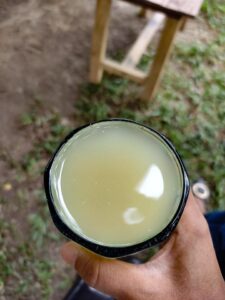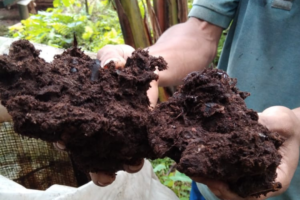Gondenggre is a small community in the interiors of the West Garo Hills district in the state of Meghalaya. This community is deeply rooted in culture, with a significant portion of the population still practicing the traditional faith, who are known as songsareks. They revere and worship nature, and highly respect the environment. The presence of adherents to the traditional faith, ensures the continuation of a cherished custom, which is the making of the traditional sticky rice wine, known as minil bitchi. A beloved local brew, it flows freely at celebrations, dances, festivals, and weddings, adding an essential touch to every auspicious occasion. Interestingly, Christian members of the community also embrace minil bitchi, with many winemakers practicing both their faith and this time-honored tradition.
The magic of minil bitchi begins with minil– the sticky rice grown in their fields or sourced from local markets. Though other rice varieties, like the staple miari which can be used, simply do not hold a candle to the unique character of minil bitchi.
The sisarat (wild fern) is a hidden hero in the story of minil bitchi. It is an ingredient that is not plucked off a shelf but is a labour of love. Found abundantly in the lush forests surrounding Gondenggre, this wild fern plays a crucial role in preserving the treasured local brew. The people carefully collect the sisarat, its fronds holding the secrets to transforming into wanti, a traditional yeast, the soul of the fermentation process.
This transformation is no small feat. Skilled hands take the sisarat on a journey. Wanti is meticulously made with sisarat, chillies and rice powder, undergoing rigorous processes such as grounding, smoking, breaking and sun-drying, among others. As days turn into weeks, the wanti awakens, transforming the simple ingredients into a symphony of flavours. The starches in the rice break down, releasing sugars that the wanti hungrily devours. In this process, the magic happens. The wanti, infused with the spirit of sisarat, breathes life into the mixture, creating a beverage that is both invigorating and soul-satisfying.
Beyond its role in brewing, the sisarat transforms into a natural, organic pesticide when mixed with garlic, castor leaves, and neem leaves. Brushing against its very leaves is sure to leave one with a burning sensation.
Prejine Ch Marak, a senior community member and a traditional knowledge holder, who has been brewing for over three decades, willingly shared her knowledge on the subject, saying, “The amount of wanti used determines the strength of the final minil bitchi concoction. The more the wanti is used, the harder the drink will be, hence flavour is stronger, and the taste is sharper. It ensures a longer shelf-life of our rice wines, which we can preserve for years and even decades.”
Prejine also shed light on the benefits of minil bitchi consumption, stating, “The minil bitchi has lots of medicinal purposes and we take it as medicine, apart from taking it as a recreational drink. It is good for treating diseases like gastritis and urine infections, does not burn our organs, and is not as harmful as whiskey”
This versatility showcases the Garo people’s deep understanding of their surroundings and their ability to utilize nature’s bounty in sustainable ways. The sisarat is not just a crucial ingredient; it is a symbol of the Garo people’s respect for and harmonious relationship with the environment.
This story has been documented as part of the TNC-supported NESFAS’ project “Protection of forests in Meghalaya by adopting participatory, gender-centric, and equitable approaches”.




